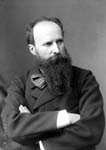Vasily Vasilyevich Vereshchagin

Vasily Vasilyevich Vereshchagin
Painter, drawer, battle artist, creator of series of studies and drawings on ethnographic nature and historical paintings.
Born to a squire’s family and marshal of nobility. From 1850-1852 he studied at the Alexandrovsky Cadet Military School at Tsarskoye Selo, from 1853-1860 he attended the Marine Military School in St.Petersburg, graduating at the rank of midshipman.
From 1858 he attended drawing classes at the Society for the Encouragement of Artist’s school. In 1860 he entered the Academy of Arts where he studied historical painting under A.T.Markov and later A.E.Beideman until 1863.
His study entitled "Massacre of Penelope’s Suitors by the Returning Ulysses" won him the small silver medal. In 1861 he virtually stopped studying at the Academy (although formally he remained a student until 1865) and travelled to the Caucasus with the help of L.F.Lagorio. In 1864 he went to Paris where he studied at the studio of J.L.Jerome at the Academy of Fine Arts, while at the same time receiving advice from H. Bide.
In 1874 he was appointed a professor at the Academy of Arts, but he declined the appointment. He travelled a great deal across Russia, Europe, the Middle East, India, the USA and Japan. Between 1879-1880 he travelled all over Europe with his picture-broadcasts, exhibiting them in the most fashionable salons. At the rank of ensign he took part in the Turkestan campaign from 1867-1868, in the corps of general K.Kaufman (awarded with the Officer’s St George Cross 4th class for his participation in the defence of Samarkand fortress). From 1877-1878 he took part in the war between Russia and Turkey in the Balkans.
Vereshchagin died along with admiral Makarov on board the Petropavlovsk battleship which hit a mine near Port Arthur during the Russian-Japan War in 1904. In 1901 he was nominated for the first Nobel Peace Prize.
Author of a number of literary and publicist works. V.Vereshchagin is famous for his series of battle paintings the first that dealt with the subject of "war atrocities".
His numerous world trips resulted in the creation of documentary ethnographic paintings. He also painted portraits and landscapes. His ideals were connected closely with the Peredvizhniki.
Vereshchagin won worldwide fame, he took part in more than 30 personal exhibitions in the last decade of his life, half of them were abroad. His earlier battle paintings were based on subjects from nature sketches he collected during his voyages. The artist united his work in a series that resembled a photographic report. Some viewers were shocked by the declarative protest against war atrocities and the impartial naturalism depicted in battle scenes and plots. Later the artist partially avoided detailed descriptions of bloody everyday combat scenes and created a number of works where descriptions were substituted by intense drama and almost symbolic images (The Apotheosis of War, 1871; "The Defeated". "The Burial Service", 1878-1879).
